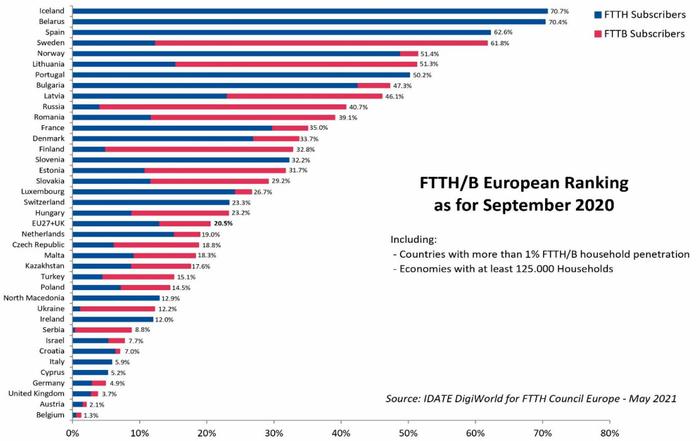The Fibre to the Home Council Europe has published its latest Fibre market Panorama report for 2021. As you might expect from the organisation / report name, this is a periodical survey of FTTH penetration across the varied nations in Europe. Looking inward, there are some good signs for UK FTTH growth and adoption. However, other nations have simply executed roll-outs of FTTH better / faster, and thus the UK remains firmly in the lower regions of the rankings table – third from bottom, just like in the 2020 report.
Key findings in the new report are bullet pointed below:
- Number of homes passed by fibre (FTTH/B) reaches nearly 183 million homes in EU39;
- France, Italy, Germany and the UK have the biggest increase in Europe in number of homes passed;
- Three countries are accounting for almost 60% of homes left to be passed with fibre in the EU27+UK region;
- FTTH/B Coverage in Europe surpasses more than half of total homes;
- 16.6% growth in the number of fibre subscribers;
- Iceland leads the European FTTH/B league table second year in a row;
- Belgium, Israel, Malta and Cyprus enter the FTTH/B ranking for the first time.
The UK has historically not been very strong in full fibre. That is probably due to infrastructure companies in the UK being 'copper-strong', and not happy about what a full fibre transition will cost. The report notes that other countries with copper-switch off inertia are Germany and Italy, and together with the UK they account for 60 per cent of the homes left in Europe without fibre.
Looking at the top of the table with some envy, we can see Iceland is ranking very well with its >70 per cent penetration rate. Yes, it might be a small, largely coastal population there but more expansive countries like Belarus, Spain and Sweden have now all achieved >60 per cent full fibre penetration.
Remember, penetration, and availability don't tally directly. Consumers must consider the switch to full fibre worthwhile when it becomes available – so it must offer a superior experience at an attractive price compared to using copper/mobile internet offerings.
Table showing full fibre coverage across Europe
We are reminded how fast internet connectivity is growingly important to how Europeans work, and to business and commerce. Full fibre gets praise from Vincent Garnier, Director General of the FTTH Council Europe, for being "the most sustainable telecommunication infrastructure technology". Governments are thus encouraged to invest in FTTH/B rollouts, especially if they are interested in pursuing the European Green Deal.















